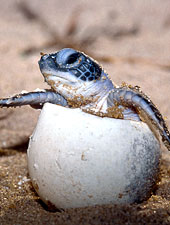- Главная
- О нас
- Проекты
- Статьи
- Регионы
- Библиотека
- Новости
- Календарь
- Общение
- Войти на сайт
Protecting Marine Turtles in Papua New Guinea
- Войдите или зарегистрируйтесь, чтобы получить возможность отправлять комментарии

Leatherback turtle hatching (Photo: WWF-Canon/Roger LeGUEN
Only 7 marine turtles exist in the world today, 6 of which are found in Papua New Guinea’s waters. These include the Flatback, the Green Turtle, the Hawksbill, the Leatherback, the Loggerhead, and Olive Ridley. The country’s coastal waters are home to the world’s largest populations of Hawksbill, Green, and Leatherback turtles. Unfortunately, as humans encroach on and pollute their habitat, numbers of these marine turtles have been in severe decline.
currently lists the Leatherback, the largest species of marine turtle, as endangered. Because the turtles mature very slowly, some taking up to 50 years to reach sexual maturity, and travel long distances from beach to beach, any impacts in one region of the world can have devastating effects on the entire marine population.
With a body that can grow up to 8 feet long and weigh up to two tons, a docile demeanor, and the need to beach to lay eggs, the Leatherback can be easy prey for human consumption. One Global Greengrants Fund grantee, , found human consumption of the Leatherback was contributing to its declining numbers, so they started a training program to promote sustainable consumption practices.

Mas Kagin Tapani Association Billboard
The trainings are the first of their kind in the area. They educate local indigenous populations on the turtle’s biology and threatened status, and then develop an action plan for conservation and sustainable management.
The target audience of the workshop included community members from the villages of Karkum, Mirap, Gildipasi, and surrounding areas. There were 62 participants at the first course.
The communities were so motivated by the trainings, they have created action plans to continue conservation efforts. Recently, they have begun tagging and monitoring nesting turtles in order to track their whereabouts and numbers. It’s a perfect example of community-led conservation in Papua New Guinea, all with just a little financial support from people like you.
Ссылка на источник новости: http://www.greengrants.org/2011/08/31/protecting-marine-turtles-in-papua-new-guinea/
Другие новости
18.04.24
|
Всемирный день тунца
16.04.24
|
ЗапоВести 28 марта-16 апреля 2024 года
15.04.24
|
Будут ли заповеданы Инзерские зубчатки?
Календарь
Другие статьи
Активность на сайте
|
|
|
|---|---|
|
2 года 19 недель назад YВMIV YВMIV |
Ядовитая река БелаяСмотрели: 289,228 | Спасибо, ваш сайт очень полезный! |
|
2 года 21 неделя назад Гость  |
Ядовитая река БелаяСмотрели: 289,228 | Thank you, your site is very useful! |
|
2 года 21 неделя назад Гость  |
Ядовитая река БелаяСмотрели: 289,228 | Спасибо, ваш сайт очень полезный! |
|
2 года 50 недель назад Евгений Емельянов |
Ядовитая река БелаяСмотрели: 289,228 | Возможно вас заинтересует информация на этом сайте https://chelyabinsk.trud1.ru/ |
|
2 года 21 неделя назад Гость  |
Ситуация с эко-форумами в Бразилии Смотрели: 8,382 | Спасибо, ваш сайт очень полезный! |









































